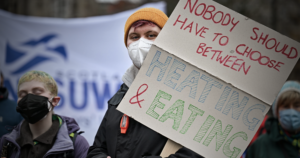
Dr Shobhana Nagraj
Shobhana is a Senior Clinical Lecturer and a Clinical Researcher at the Centre for Tropical Medicine & Global Health at the University of Oxford.
The Covid-19 pandemic has impacted upon household food security across the UK, and exposed the widening health inequalities identified by the ‘Marmot Review 10 Years On’. The most deprived households with children, have been particularly affected, with 2.3 million children experiencing food insecurity between August 2020 and January 2021. During this time, the voluntary sector has made important contributions in tackling child food poverty, with grassroots organisations coordinating emergency food response for those most in need. Voluntary organisations across all four nations have mobilised local resources, contributed to meaningful community engagement, restored a sense of local pride, and established social networks for some of the most marginalised in society. These efforts have often been in partnership with local authorities, through provision of short-term government grant funding. The future sustainability of such models of funding is, however, unclear.
The economic downturn for many families resulting from job insecurity during the pandemic, coupled with the rising cost of living, has meant that the need for emergency food provision will increase in the following months. Voluntary organisations providing essential food services to vulnerable households are likely to struggle to keep up the morale and efforts which bonded the community during the pandemic, without adequate ongoing government funding and support. There is also a more pressing need to move beyond provision of emergency food response and to consider the systemic factors impacting child food poverty, to build resilient, affordable and sustainable food systems.
The Government’s Levelling Up agenda outlines the need for improving public services, restoring a sense of community and empowering local leaders and communities through harnessing six forms of capital. By virtue of the trust and relationships formed both prior to, and during the pandemic, voluntary organisations hold significant social capital within their communities, and are ideally placed to contribute to “Levelling-Up”. The question remains however, as to ‘What the government can do to support the voluntary sector to address the systemic issues relating to child food poverty?’
Creating opportunities for intersectoral dialogue
Ensuring positive impact around the issue of child food poverty in the UK, requires breaking down the professional silos which have hereto prevented voluntary organisations from participating in meaningful dialogue with policy-makers, local authorities, industry and academia. Providing opportunities for important community-based narratives to be shared with those with local and national decision-making capacity in a psychologically safe, neutral space is achievable and powerful, and can lead to local policy change, as highlighted by a recent roundtable meeting on childhood malnutrition held in Oxfordshire. Such dialogue can foster intersectoral collaboration across local authorities, government, academia and grassroots community groups, in particular with regards to research & development.
Focusing on community-based research and data harmonisation across local authorities
Empowering and involving grassroots food organisations with the skills and resources to engage in research & development that is meaningful to their communities, is at the heart of community-based participatory research. In practice, this may involve aligning community-led research priorities and impact evaluation of local child food poverty initiatives, with key performance indicators of both local authorities and national government, in collaboration with local academia. Community-led data collection may help document local trends in health inequalities and the social impact of local initiatives. Data harmonisation of these key indicators at both a local and a national level, might further contribute to research & development outlined within the Government’s levelling up agenda, and enable prioritisation of funding and more effective sharing of resources.
Encouraging assets-based community development
Local communities hold capital in the form of individuals and their skills, voluntary organisations and their connections to marginalised groups, local institutions including schools and higher education institutions, and place-based assets such as land and buildings. Government-led initiatives to encourage locally-driven, assets-based development can be instrumental in community wealth building. This might be achieved for example, through supporting voluntary organisations in developing more sustainable models of funding, and encouraging larger businesses to support local food provision in line with corporate social responsibility agendas. There are examples of voluntary food organisations which have during the course of the pandemic created cooperatives and founded social enterprises, thereby providing a sustainable model for ongoing food provision to their communities.
Celebrating successful models and sharing best practice through regional and national networks
Finally, recognising and valuing the immense contribution of the voluntary sector and community engagement in addressing child food poverty is an intangible but important motivator to ensure ongoing sustainability of voluntary organisations. At a local level, this might be achieved through community award and recognition schemes, and through national conferences that celebrate and recognise individual efforts as well as share best practice across the four nations.
Why is addressing child food poverty of urgent importance to Levelling Up?
Childhood malnutrition resulting from child food poverty in the UK is a hidden issue. Children in the most deprived areas of the country are more than twice as likely to be obese compared to those living in the least deprived areas. Investing in the nutrition of our children has long-term health and economic benefits for the population. Such investment requires a whole systems approach which recognises the importance of intersectoral working, and considers the entire food system, consisting of inter-dependent stakeholders working to provide easy access to affordable and nutritious food for the whole population, and particularly for the most marginalised and vulnerable in society. The strategies outlined are equally applicable to Scottish voluntary organisations and those working across all four nations. The voluntary sector and community engagement are integral to achieving a society in which every child can thrive. To date, they have been working by intrinsic motivation alone, it is now time that the power of communities are harnessed to create sustainable improvements to the widening social and health inequalities facing our children across the UK.





